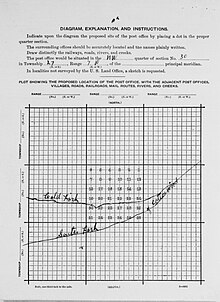


Cold Fork, California is a historical crossroads and small settlement [2] along Cold Fork Creek, a river tributary of the Cottonwood Creek in Tehama County, in the U.S. state of California, recorded on some historical maps as a district. [3] [4] The tributary, which is a fork of the South Fork of Cottonwood Creek, rises on the east slope of North Yolla Bolly Mountain, and flows generally east from there for about 22 miles (35 km) falling from an altitude of 6,000 feet (1,800 m) above sea level to 5,200 feet (1,600 m). [5]
According to local residents at Hunters (see later) it was known as Cold Fork simply because the water was cold. [2] Anecdotally it was also known as Cole Fork after a local resident named Cole, although there is little historical evidence of this on maps. [6]
In 1876 it bordered on C. Petty John's Farm. [6] Pettyjohn, as it later became known, was a stopping place. [7] It was on the wagon road to Hay Fork. [8] [9] The Humboldt Trail, also known as the Red Bluff to Humboldt Trail, between the inland valleys and the coast, also used to pass by Pettyjohn in the 19th century, beginning at a place known as Jones further along Cold Fork and taking a meandering path that does not strictly follow the line of the Fork. [1] It followed the route of a Native American trail passing by North Yolla Bolly Mountain, and was used by 19th century settlers initially for livestock and later as a general supply trail. [1] [9]
The "Pettijohn country," as it was sometimes called, was described in 1928 as a rugged area that was somewhat difficult to navigate. [10] In 1975 and 1960 (the latter extended to 1967) studies were done on the Pettyjohn Range, one of four sites studied, as to the feasibility of brush removal and converting chemise to grassland for farming livestock. [11] [12]
There are indications in historical records that Pettyjohn Place was the location of a Civilian Conservation Corps camp. [3]
During a drought in 1883, stockmen were scraping "six feet in the creek bed" to find water for animals. [13] A male mountain lion killed near Cold Fork was one of several killed in 1921 by an officer of the California Fish and Game Commission. [14]

Hunters was a post office to the north of Cold Fork, [15] which also had a nearby school, Hunter School, approximately 1.5 miles (2.4 km) north of Cold Fork on what was in 1997 still named Hunter Road. [15] [16] There was a school at Cold Fork itself in 1888 and 1891 but in 1892 Cold Fork schools were declared "lapsed" and merged with the Hunter schools. [17] [18] [19] A post office was established at Cold Fork in 1915, 15 miles (24 km) southwest of Hunters, and remained in operation until 1920 when it moved to Hunters. [3] Its postmaster in 1918 was Laura French Heitman. [20] After the post office closed, the building became a residence. [6]
Nothing remained of Hunters as of 1997 except a cattle ranch. [20]
References
- ^ a b c Smith 1997, pp. 58–59.
- ^ a b Smith 1997, p. 63.
- ^ a b c Hislop & Hughes 2007, p. 15.
- ^ Wood 1912, p. 23.
- ^ Wood 1912, p. 25.
- ^ a b c Smith 1997, p. 39.
- ^ Smith 1997, pp. 39–40.
- ^ Bluffer 1888.
- ^ a b DS 1892a.
- ^ RBTCDN 1928.
- ^ Brown 1975.
- ^ CDF 1969, pp. 16, 20.
- ^ MAW 1883.
- ^ RBTCDN 1921.
- ^ a b Smith 1997, p. 65.
- ^ Smith 1997, p. 41.
- ^ WS 1888.
- ^ Miller 1891.
- ^ DS 1892b.
- ^ a b Smith 1997, p. 40.
Sources
- Hislop, Donald L.; Hughes, Benjamin M. (2007). "Place Names" (PDF). Red Bluff, California. Archived from the original (PDF) on 8 May 2017. Retrieved 25 March 2018.
- Smith, Dottie (1997). Ritter, Eric W. (ed.). Historical Overview of the Western Tehama County Foothills. Bureau of Land Management, Redding Resource Area.
- Wood, Beatrice Dawson (1912). Gazetteer of Surface Waters of California. Geological Survey (U.S.). Water-supply paper. Vol. 295–297. U.S. Government Printing Office.
- Brown, Robert D. (1975). "PETTYJOHN BRUSH REMOVAL STUDY". Range Improvement Studies. California Department of Forestry.
- "BRUSHLAND RANGE IMPROVEMENT 1972". Brushland Range Improvement Annual Report. California Division of Forestry. 1969.
- MAW (1883-08-17). "Tehama Notes". The Napa Register. p. 3. Retrieved 2023-11-03.
- Bluffer (1888-09-08). "Cold Fork Camp Meeting". Weekly Sentinel. p. 3. Retrieved 2023-11-03.
- Miller, Belle (1891-06-13). "School apportionments". Tehama County Daily Republican. p. 8. Retrieved 2023-11-03.
- "The Surveyors". Daily Sentinel. 1892-05-06. p. 3. Retrieved 2023-11-03.
- "Pettijohn Fire Sweeps Great Area Unchecked". Red Bluff Tehama County Daily News. 1928-06-07. p. 1. Retrieved 2023-11-03.
- "Bruce, Noted Lion Hunter, Kills Several Panther West of City". Red Bluff Tehama County Daily News. 1921-07-25. p. 1. Retrieved 2023-11-03.
- "Tehama County Teachers for 1888–89". Weekly Sentinel. 1888-08-11. p. 2. Retrieved 2023-11-03.
- "Supervisors". Daily Sentinel. 1892-02-03. p. 3. Retrieved 2023-11-03.
Further reading
- Fairbanks, Harold W. (1893). "Notes on the geology and mineralogy of portions of Tehama, Colusa, Lake, and Napa counties". California Journal of Mines and Geology. 11. California Division of Mines and Geology.
